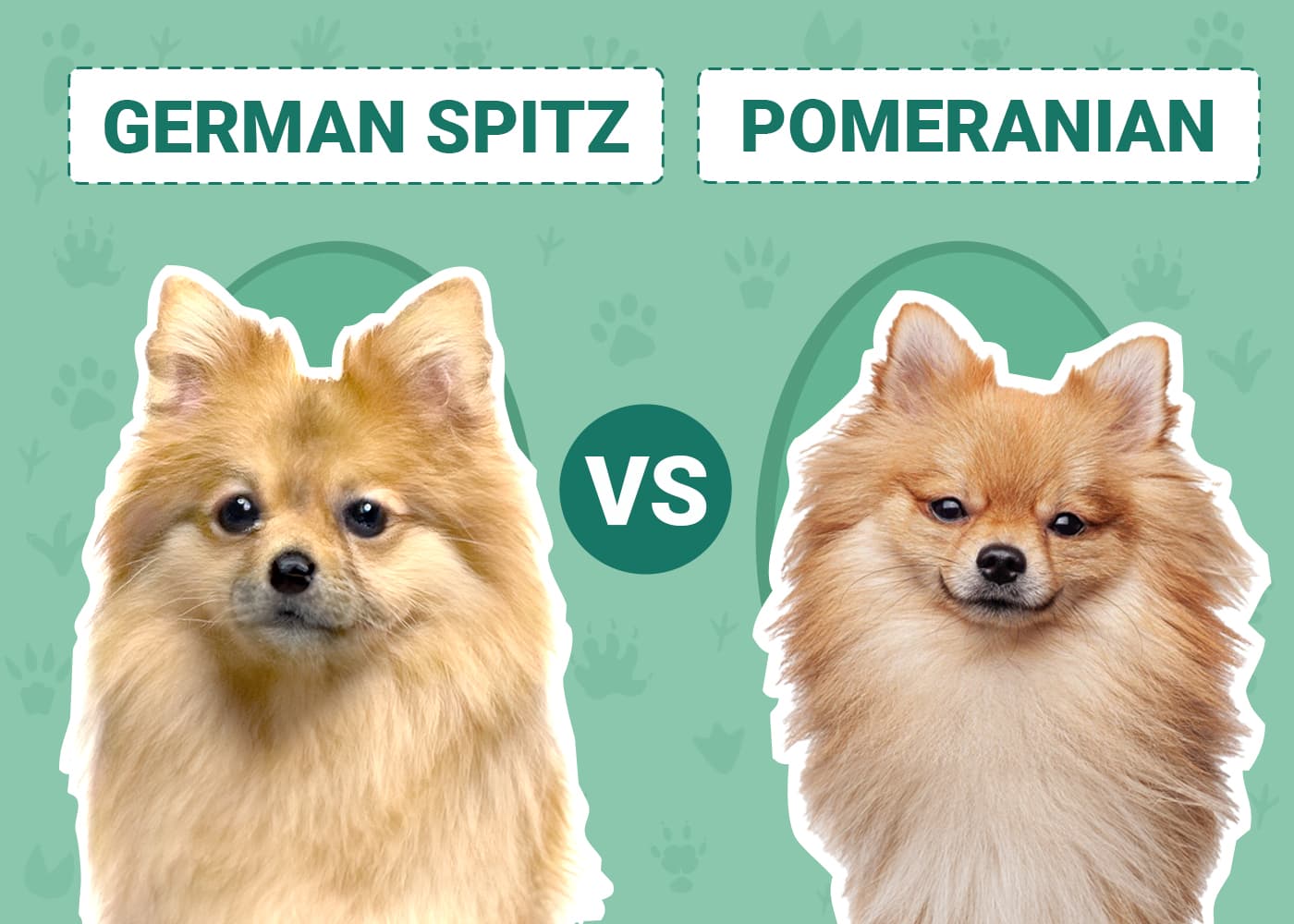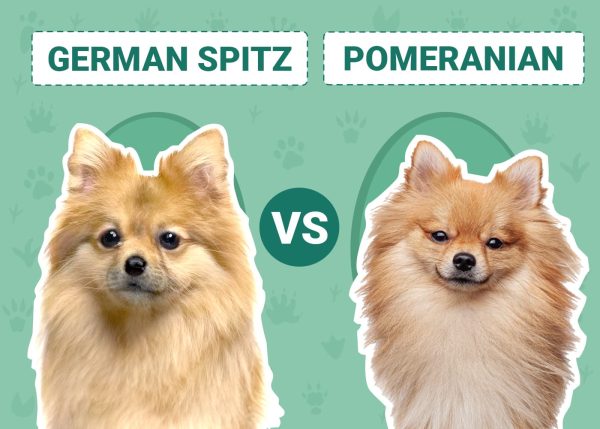Click to Skip Ahead
The German Spitz and the Pomeranian are very similar yet have differences that separate them into their own breeds. While they’re related under the same family tree and descend from herding dogs, breeders shaped the German Spitz and Pomeranian for different reasons. The German Spitz is a Nordic dog primarily bred for herding and guarding, with a rich history dating back to 1450. The Pomeranian, with its rounded body and diminutive stature, is thought to be named after Pomerania in Poland. Spitz-type dogs were bred smaller and smaller, and the Pomeranian was first referenced in 1764.
This selective breeding gave the dogs key differences, which we’ll discuss today; read on to discover which fluffy pups could be perfect for you.
Visual Differences
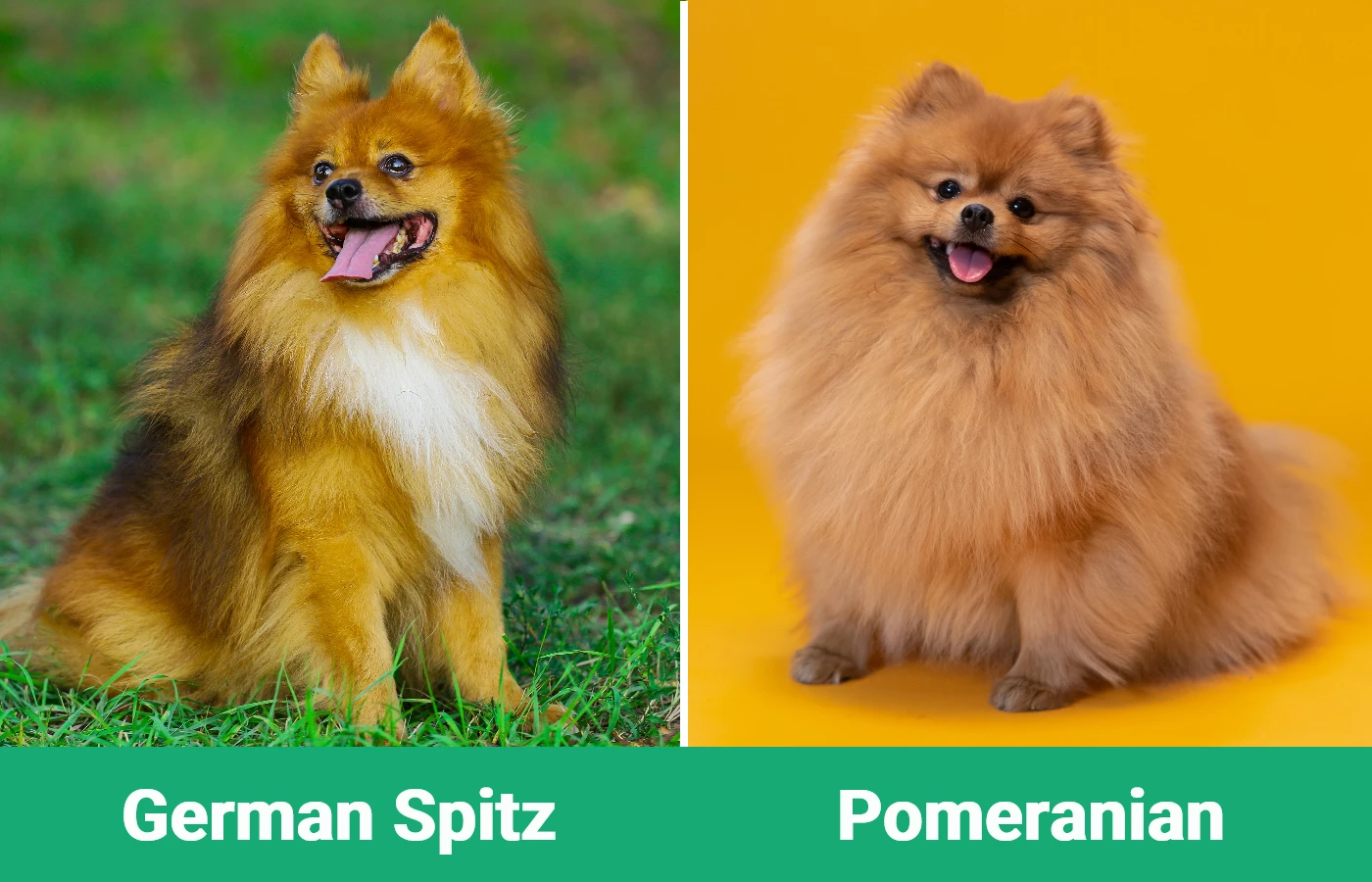
At a Glance
- Average height (adult): 8–20 inches
- Average weight (adult): 10–50 pounds
- Lifespan: 13–15 years
- Exercise: 1+ hours a day
- Grooming needs: Moderate
- Family-friendly: Mostly
- Other pet-friendly: Sometimes
- Trainability: Intelligent, hard-working, independent
- Average height (adult): 6–7 inches
- Average weight (adult): 3–7 pounds
- Lifespan: 12–16 years
- Exercise: 30 mins– 1 hour a day
- Grooming needs: Moderate
- Family-friendly: Yes
- Other pet-friendly: Often
- Trainability: Intelligent, energetic, eager to please
German Spitz Overview
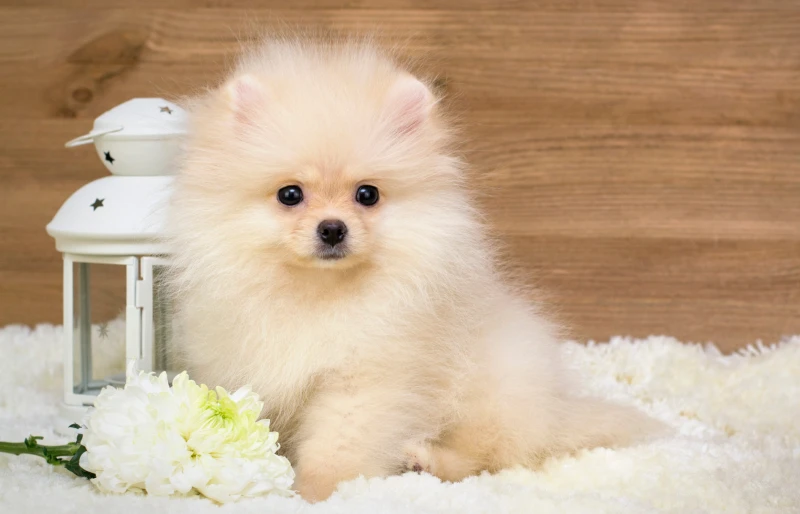
The German Spitz comes in three sizes: large, medium, and small. These three dogs are all descended from Nordic herding dogs, similar to the ancestors of the Samoyed and Swedish Lapphund. German Spitz dogs are energetic and attentive and were bred as working farm dogs undertaking tasks such as herding and guarding. However, while these dogs are highly intelligent, they can also be stubborn and refuse to perform if they feel they’re being made to!
Personality
The German Spitz is keen and devoted to its owners, but they can distrust strangers due to their guarding heritage. However, the German Spitz is nothing if not doting on its family, and the instinct to protect and alert its people makes them great watchdogs. This is true even though they aren’t aggressive to people and lack the hunting drive of other guard dogs.
The German Spitz is known to be independent and not stuck to its owners, and they’ll take their own space when needed. That’s not to say they aren’t loving, but they were not bred to be lap dogs. Socialization is required for puppies to ensure the German Spitz is comfortable with people from all walks of life as well as other pets. However, they generally tolerate other dogs and are a naturally curious and adaptive breed.
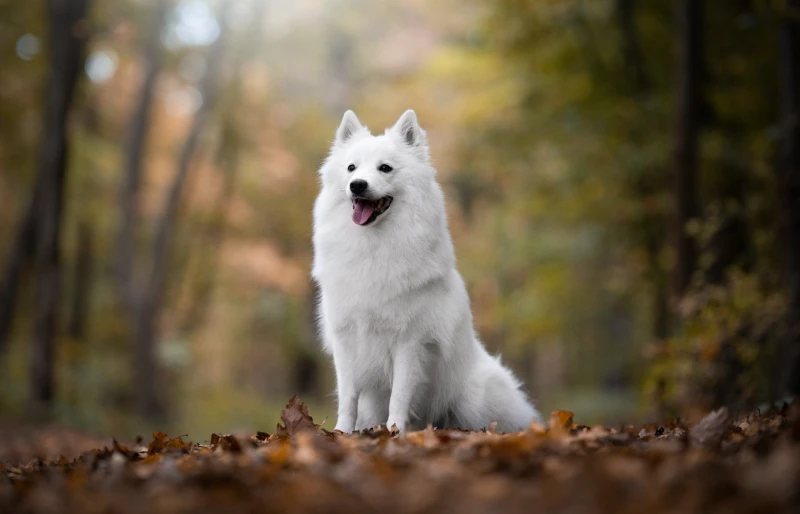
Training
Socialization and bark training are the two critical elements of training a German Spitz. These dogs are very intelligent and will take to training with ease, but they can be nervous around strangers if they are correctly socialized. They will bark (sometimes excessively) if training to temper the behavior is not implemented.
When properly trained, the German Spitz will bark to alert its owners of danger but will not engage in unnecessary vocalizations. Because they’re so smart, these dogs need varied and exciting training to keep them engaged. They have a stubborn streak, so they won’t take well to being told what to do if there’s nothing in it for them, and they can lose interest quickly.
Exercise
The German Spitz is a working breed, so they need enough physical and mental stimulation to keep them healthy and happy. Depending on the size of your German Spitz, 1 to 2 hours of exercise spread throughout the day should be enough.
They are great at dog sports, such as agility courses. Ensuring enough exercise is essential, as undesirable behaviors such as excessive barking and destruction can occur if they’re not properly stimulated.
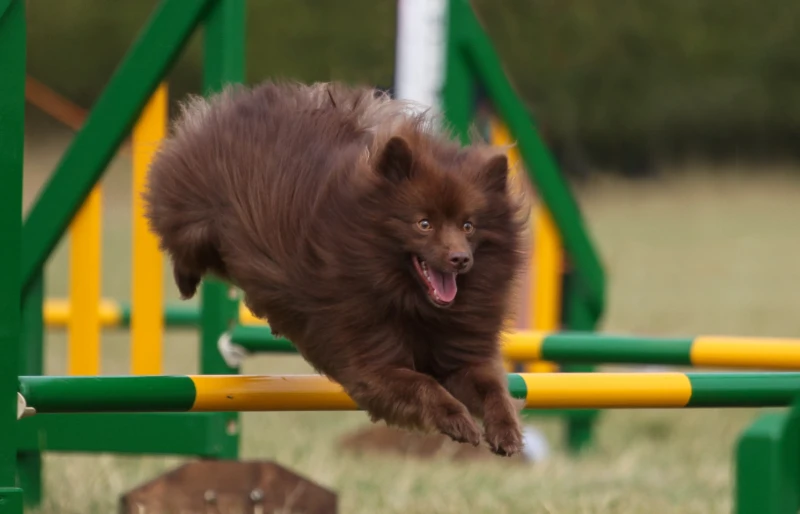
Grooming
German Spitzes have a thick double coat that predominantly sheds twice a year. They’ll need daily grooming during their shedding seasons to reduce the amount of loose fur around your home and keep them comfortable.
They shouldn’t be bathed too often since German Spitzes can suffer from excessively dry, uncomfortable skin. Nail clips should be done ad-hoc when needed if not worn down on hard surfaces, and their teeth should be brushed at least once a day to ensure correct oral hygiene.
Health & Care
Generally, the German Spitz is relatively healthy, with only a few health conditions that are slightly more common in the breed than others. However, if you’re considering a German Spitz, you should be aware of the following possible health problems:
- Dry Skin: Skin becomes itchy, flaky, and dry. Excessive bathing, overgrooming, allergies, and a poor diet can cause dry skin.
- Progressive Retinal Atrophy: A condition in which eye cells degrade over time, leading to blindness.
- Patellar Luxation: The patella (knee) is not anchored to the underlying joint correctly, causing it to luxate (slip) out of place.
Suitable for:
The German Spitz is suitable for families who love the fluffy, teddy-bear look of the breed but want some variety in size. If families are looking for a small watchdog, the smaller variants of the German Spitz are an excellent choice. However, these dogs are not for everyone; if you’re looking for an easygoing dog who wants to snuggle all the time, the German Spitz probably won’t fit your lifestyle. However, if you’re prepared to put time and effort into their training and exercise, you’ll have a wonderfully intelligent and active companion that will dote on you and your family.
- Available in various sizes
- Active and Intelligent
- Alert Watchdog
- Needs time away from the family
- Can bark excessively
- Not a lap dog
Pomeranian Overview
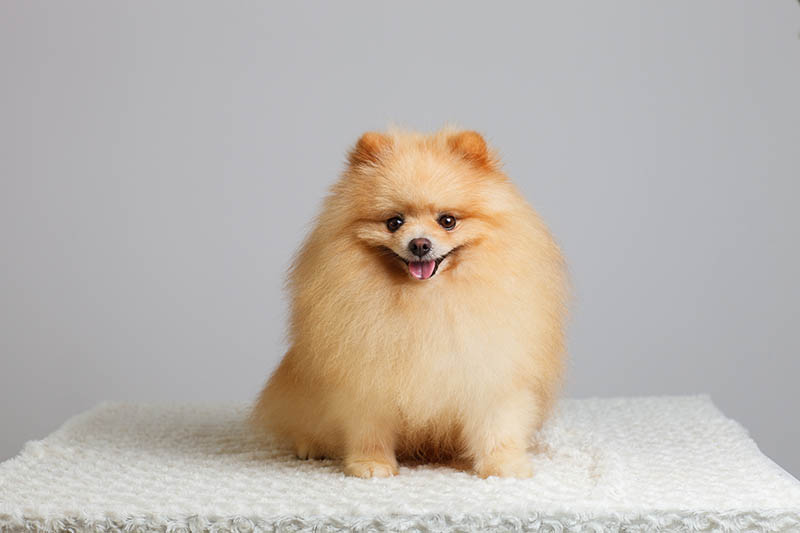
The tiny Pomeranian is one of the most famous toy breeds. Loved by the general public and celebrities alike, these spirited dogs seem to stuff a giant personality into the smallest package. Hailing from the same ancestors as the German Spitz, they’re very alike at first glance. But, the Pomeranian was bred for companionship rather than work. This is reflected in their desire to always be beside their owners!
Personality
A big dog in a small dog’s body is the best way to describe the vivacious Pomeranian. These dogs are bundles of energy that often defy their diminutive size, and they adore being the clowns in the room. They’re true companions that love to be around their owners at all times. Pomeranians will often follow them from room to room, in sharp contrast to the German Spitz’s independence. However, the Pomeranian will still use its voice, and they are small but mighty when it comes to stubbornness. They’re friendly dogs that get along well with other pets and children, but small children must distinguish them from toys that can be picked up and tossed around!
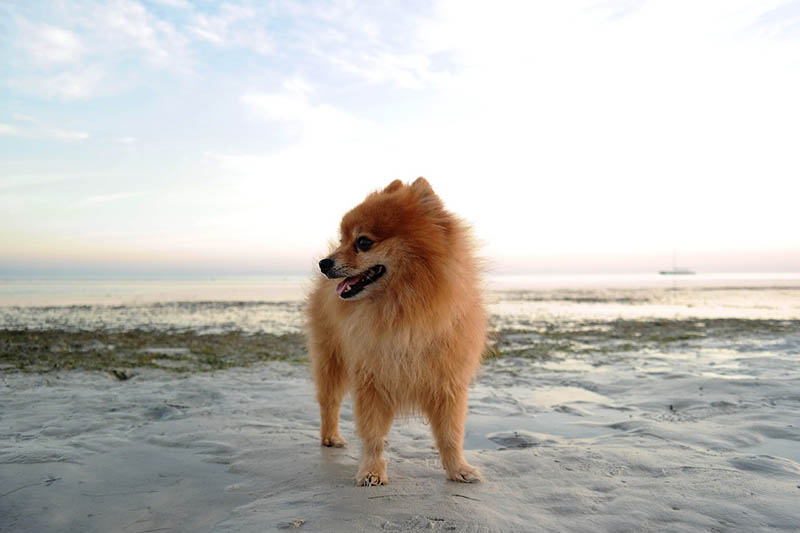
Training
Pomeranians are intelligent dogs that can quickly become bored without structure. They need adequate socialization as puppies to be comfortable with the big world around them and strict housetraining. Like most toy dogs, Pomeranians can be troublesome to housebreak, so beginning training early and using positive methods is a must.
They’re just as prone to barking as German Spitzs are, so training the behavior out of them and channeling their energy into better activities will make life easier for everyone.
Exercise
The Pomeranian is energetic and lively, particularly for a lap dog. They need around an hour of exercise daily, which can easily be undertaken because of their size. Playing interactive games inside the house can count towards daily exercise as long as it gets them running. However, the little Pom should be allowed to take a brisk walk outside daily for exercise and enrichment.
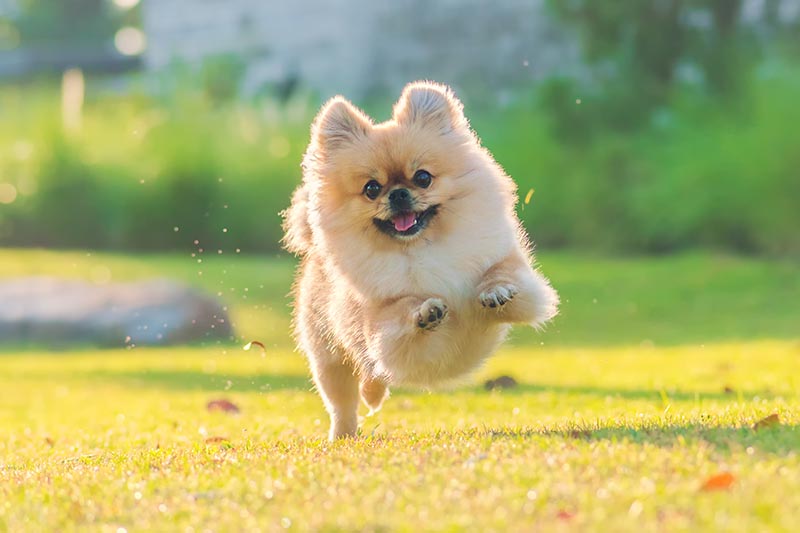
Grooming
Pomeranians have a similar double coat as the German Spitzes, with similar grooming needs. The Pom’s coat is longer and fluffier than the Spitz’s, so daily grooming is usually recommended to prevent tangling and matting (particularly around the inner leg).
Overbathing a Pomeranian can also cause disastrously dry skin, so only bathe them if they really need it. Because Pomeranians often suffer from tooth problems and dental disease, daily brushing is essential to their health and well-being. Clipping nails should be done as regularly as needed, especially if they get less time outside to wear them down naturally on hard surfaces.
Health & Care
Because Pomeranians are toy breeds, they suffer from some health problems common in dogs their size. Breeders often screen their litters for health problems and markers indicating some of these conditions to improve the health of the breed.
- Dental disease
- Obesity
- Tracheal Collapse: A condition in which cartilage rings supporting the trachea (the windpipe) weaken and collapse, compromising the trachea and causing a honking cough, exercise intolerance, and breathing issues.
- Alopecia X/Black Skin Disease: A skin condition that causes hyperpigmentation, turning it dark and sometimes leathery with wide patches of hair loss.
- Congestive Heart Failure: A heart condition that causes the heart to fail. Signs include a cough, blue gums, breathlessness, and fluid build-up in the abdomen, depending on which side the heart is failing on.
- Patellar luxation: This occurs when the dog’s kneecap becomes dislodged from the femur.
Suitable for:
The Pomeranian is suitable for anyone who wants a portable, apartment-happy dog with a giant breed personality. Families with respectful children will gain a doll-sized playmate in the Pomeranian, who is happy to zoom around on walks before crashing out on a comfy lap. Very active families might find the small Pom unable to keep up (though not through lack of trying), and those with noise sensitivities or restrictions might not be able to take the Pom’s predilection to bark.
- Loving and loyal
- Energetic
- Loves to be around people
- Noisy
- Can be difficult to house train
- Can’t keep up on very long walks
Which Breed Is Right for You?
The German Spitz and the Pomeranian are similar yet different breeds that offer unique benefits and drawbacks to prospective pet parents. Which breed is right for you out of the two depends on your lifestyle and what you’d ultimately like out of owning a dog. If you’re an active household who wants a loving yet laid-back dog and can enjoy its time alone, the German Spitz is the dog for you. They are more independent but active and devoted and still have a teddy-bear look that people love.
However, if you want a lap dog with an incredible zest for life that is compact and portable, the Pomeranian is the better choice. Both dogs won’t suit owners who don’t take time to train them or have issues with barking. No matter which dog you adopt, both breeds make excellent companions if they’re loved and cared for properly.
Related Reads:
- Teacup Pomeranian vs. Pomeranian: The Differences (With Pictures)
- Chow Chow vs. Pomeranian: The Differences (With Pictures)
Featured Image Credit: Top – German Spitz (Lenkadan, Shutterstock) | Bottom – Pomeranian (Tam and Trace Photography, Shutterstock)

